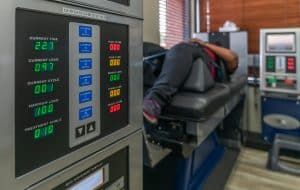
What causes a spine to be compressed?
Your spine is made up of 33 vertebrae stacked on top of one another. They start at the very base of your skull and go all the way down to your pelvis. Between each vertebra are intervertebral discs- gel-like discs that can act as a shock absorber to protect the vertebral bones from grinding together.
Over time, due to the weight of the head and the force of gravity, the discs can become compressed between the vertebrae. This compression can cause the disc to slip out of alignment or swell and bulge, which will irritate the nerves connected to and surrounding it. In an effort to protect the spine, muscles attached to the vertebrae will tighten to reduce movement and impact, which in turn may lead to poor posture.
This can cause a positive feedback loop, a perpetual increase of bad habits that cause more bad habits. The spine becomes compressed, the disc becomes irritated, and the muscles tighten which leads to a bad posture. This causes more irritation, which leads to worse posture and torque on the vertebrae, which increases the compression on the discs.
And so the cycle continues.
Essentially, the longer a compressed spine is left untreated, the worse the pain gets, and the more likely you are to end up with a spinal injury.
What is spinal decompression therapy?
The compression placed on the discs irritates the attached nerves causing chronic back pain. It’s your body’s way of saying “Hey! Our spinal health is very important! Fix the problem immediately!”
Spinal decompression therapy is used to relieve the pressure being put on the intervertebral discs. There are a number of approaches to spinal decompression therapy- physical therapy, traction stretches, lifestyle changes, or in severe cases, even surgery.
Physical therapists can offer a multitude of exercises and stretches you can do at home. However, this can be a long process as not only do you first have to untrain the bad habits but then retrain good ones. Proper form and dedication to technique are vital in this process.

Lifestyle changes may be the answer if back pain is mild and only just setting in. Take careful note of static positions that cause pain, and the ones that provide relief. Static positions are ones we hold for long periods such as sleeping, sitting at a desk, driving for more than 30min, or standing in one spot for prolonged periods. Strengthening the muscles on the front of the body, such as pecs and abs, can also help relieve back pain.
Surgery should always be a last resort. Consult your doctor about options prior to invasive surgery for back pain as all spinal surgeries have a chance of complications.



Recent Comments